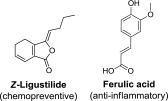Botanicals and Their Bioactive Phytochemicals for Women's Health
- PMID: 27677719
- PMCID: PMC5050441
- DOI: 10.1124/pr.115.010843
Botanicals and Their Bioactive Phytochemicals for Women's Health
Abstract
Botanical dietary supplements are increasingly popular for women's health, particularly for older women. The specific botanicals women take vary as a function of age. Younger women will use botanicals for urinary tract infections, especially Vaccinium macrocarpon (cranberry), where there is evidence for efficacy. Botanical dietary supplements for premenstrual syndrome (PMS) are less commonly used, and rigorous clinical trials have not been done. Some examples include Vitex agnus-castus (chasteberry), Angelica sinensis (dong quai), Viburnum opulus/prunifolium (cramp bark and black haw), and Zingiber officinale (ginger). Pregnant women have also used ginger for relief from nausea. Natural galactagogues for lactating women include Trigonella foenum-graecum (fenugreek) and Silybum marianum (milk thistle); however, rigorous safety and efficacy studies are lacking. Older women suffering menopausal symptoms are increasingly likely to use botanicals, especially since the Women's Health Initiative showed an increased risk for breast cancer associated with traditional hormone therapy. Serotonergic mechanisms similar to antidepressants have been proposed for Actaea/Cimicifuga racemosa (black cohosh) and Valeriana officinalis (valerian). Plant extracts with estrogenic activities for menopausal symptom relief include Glycine max (soy), Trifolium pratense (red clover), Pueraria lobata (kudzu), Humulus lupulus (hops), Glycyrrhiza species (licorice), Rheum rhaponticum (rhubarb), Vitex agnus-castus (chasteberry), Linum usitatissimum (flaxseed), Epimedium species (herba Epimedii, horny goat weed), and Medicago sativa (alfalfa). Some of the estrogenic botanicals have also been shown to have protective effects against osteoporosis. Several of these botanicals could have additional breast cancer preventive effects linked to hormonal, chemical, inflammatory, and/or epigenetic pathways. Finally, although botanicals are perceived as natural safe remedies, it is important for women and their healthcare providers to realize that they have not been rigorously tested for potential toxic effects and/or drug/botanical interactions. Understanding the mechanism of action of these supplements used for women's health will ultimately lead to standardized botanical products with higher efficacy, safety, and chemopreventive properties.
Copyright © 2016 by The Author(s).
Figures







































References
-
- Abdel-Aziz H, Windeck T, Ploch M, Verspohl EJ. (2006) Mode of action of gingerols and shogaols on 5-HT3 receptors: binding studies, cation uptake by the receptor channel and contraction of isolated guinea-pig ileum. Eur J Pharmacol 530:136–143. - PubMed
-
- Abenavoli L, Capasso R, Milic N, Capasso F. (2010) Milk thistle in liver diseases: past, present, future. Phytother Res 24:1423–1432. - PubMed
-
- AbouZahr C. (2014) Progress and challenges in women’s health: an analysis of levels and patterns of mortality and morbidity. Contraception 90(6, Suppl)S3–S13. - PubMed
-
- Adlercreutz H. (2002) Phyto-oestrogens and cancer. Lancet Oncol 3:364–373. - PubMed
-
- Agarwal R, Agarwal C, Ichikawa H, Singh RP, Aggarwal BB. (2006) Anticancer potential of silymarin: from bench to bed side. Anticancer Res 26 (6B):4457–4498. - PubMed
Publication types
Grants and funding
LinkOut - more resources
Full Text Sources
Other Literature Sources

